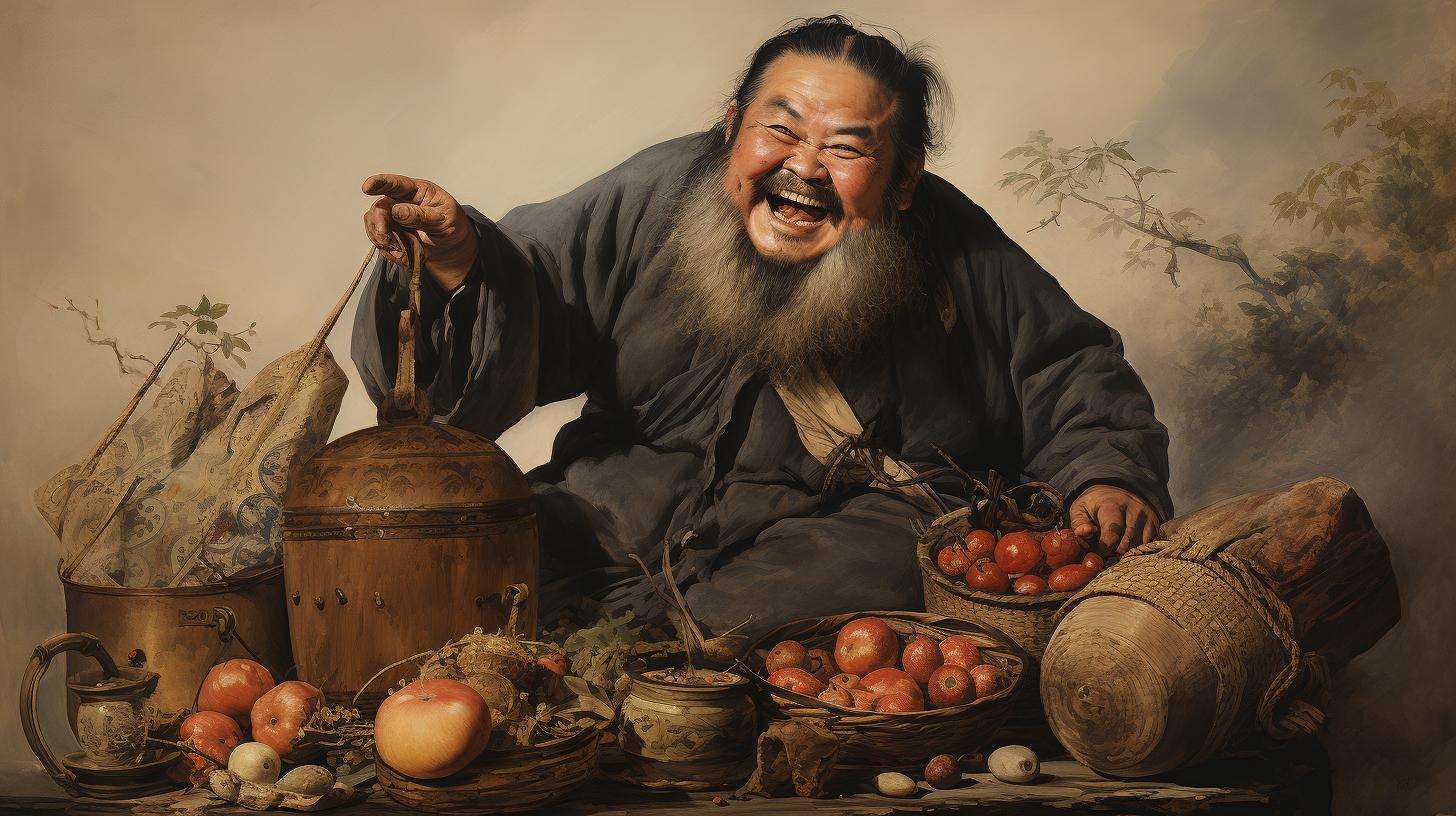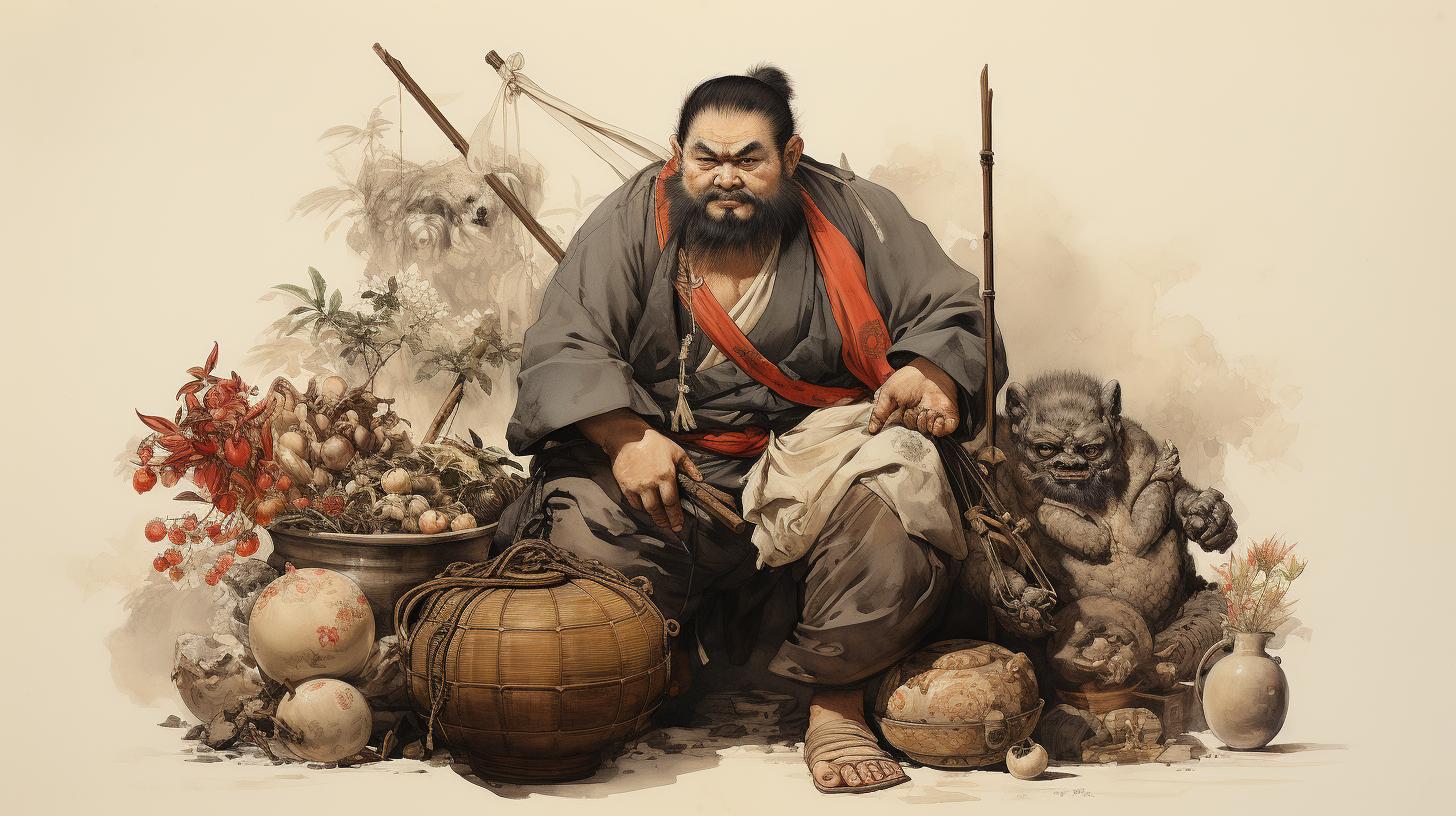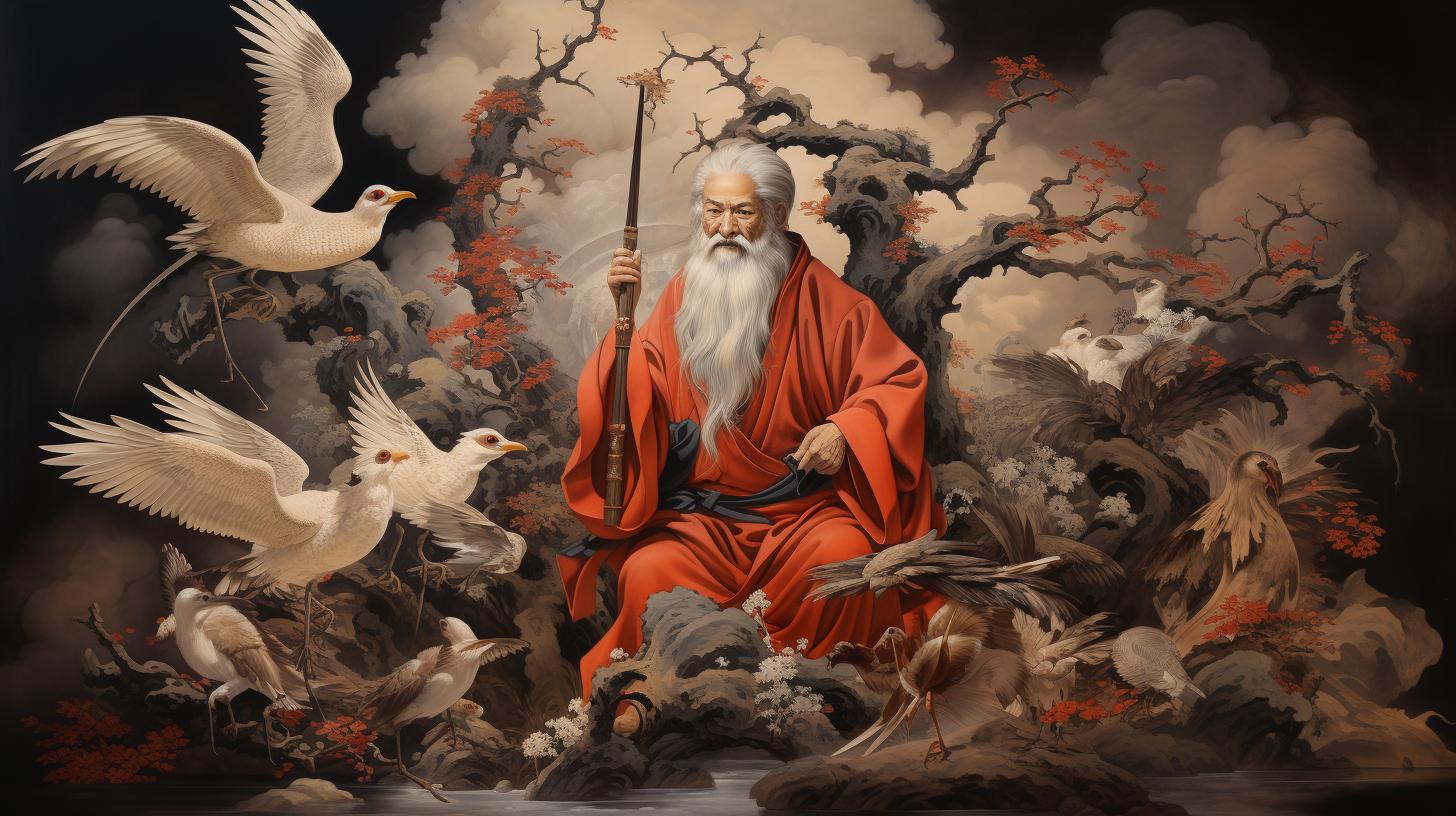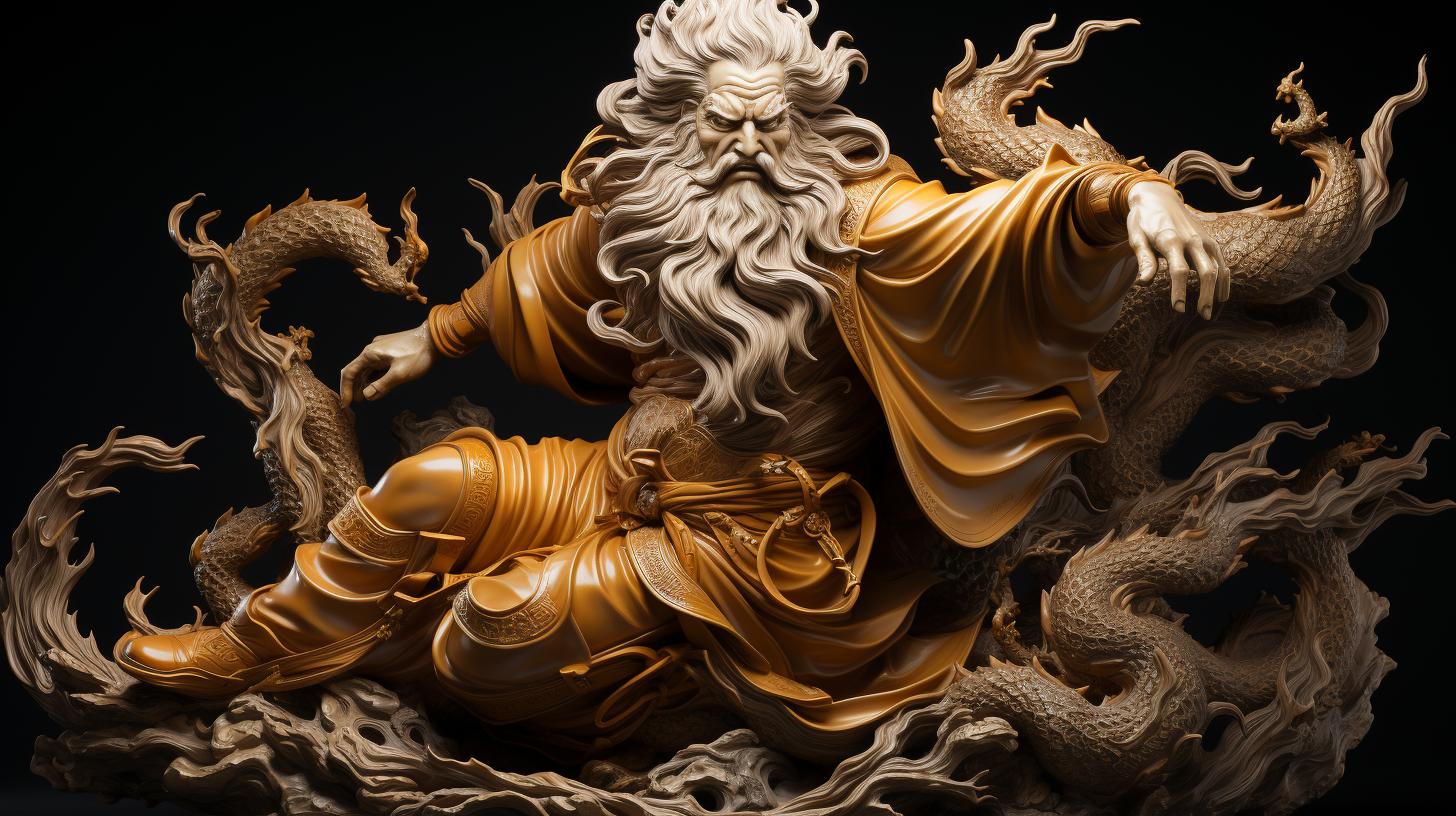Hotei Japanese God: The Patron Saint of Happiness and Prosperity

Hotei is one of the most popular deities in Japanese culture. He’s known for his cheerful appearance, portly physique, and the bag of treasures he carries. As the patron saint of happiness and prosperity, Hotei has become a beloved figure associated with good fortune and blessings.
This article explores Hotei’s history, symbolism, and significance in Japanese art and culture, as well as his connection to the Laughing Buddha.
Who is Hotei?
Origins and History
Hotei is a beloved deity in Japanese culture, revered for his association with good luck, prosperity, and happiness. Hotei’s origins trace back to ancient China, where he was an eccentric monk known for his jovial nature and generous spirit.
Over time, his story and image became intertwined with Chinese folktales and religious traditions, eventually making their way to Japan. In Japanese Buddhism, Hotei is known as one of the Shichi Fukujin, or Seven Lucky Gods, and his iconography is often associated with a treasure bag full of riches and blessings.
Hotei has long been revered for his benevolent nature, his love of children, and his ability to bring good fortune to those in need.
Hotei’s Depiction and Characteristics
Hotei is often depicted as a plump, bald man with a jovial expression, a ruddy complexion, and a long, curly beard. His simple clothing and bare feet are in keeping with his humble, unassuming nature, and his ample belly is said to represent his ability to provide succor and good fortune to those in need.
One of Hotei’s most recognizable attributes is his enormous treasure bag, which he is often shown carrying over his shoulder. The bag is said to contain endless riches, blessings, and good luck, which Hotei freely dispenses to those he meets.
Despite his jolly, affable nature, Hotei is also a powerful deity, with the ability to grant wishes, bring protection, and ensure good fortune to those who honor him.
Hotei in Japanese Culture
Hotei is a prominent figure in Japanese culture, and is part of the Shichi Fukujin, the group of Seven Lucky Gods that represent values and beliefs integral to Japanese culture. This section will delve into the different aspects of Hotei’s place in Japanese culture, including his depiction and characteristics, traditions and practices associated with him, and his presence in Japanese arts and culture.
The Seven Lucky Gods
The Seven Lucky Gods are revered in Japanese culture for their association with good fortune and prosperity. This group of deities includes various gods and goddesses who are believed to bring blessings and luck to those who pray to them.
Hotei is one of the Seven Lucky Gods and is one of the most beloved amongst them.
Introduction to the Seven Lucky Gods
The Seven Lucky Gods are often depicted as a group of deities who represent cultural values and beliefs in Japanese society. They are believed to bring good luck and prosperity to those who honor and pray to them, and are often depicted in artwork and literature.
Hotei and the Shichi Fukujin Group
Hotei is considered to be part of the Shichi Fukujin group, alongside other deities including Benzaiten, Daikokuten, Bishamonten, Fukurokuju, Jurojin, and Ebisu. As a member of this group, Hotei is associated with good fortune, prosperity, and abundance.
Traditions and Practices Associated with Hotei
There are various traditions and practices associated with Hotei in Japanese culture. Many believe that Hotei brings good fortune and prosperity to those who pray to him. Some traditions associated with Hotei include the practice of rubbing his statue for good luck, placing images of him in treasure ships during the New Year, and visiting temples and shrines dedicated to him.
Hotei’s Connection with Good Fortune
Hotei is strongly associated with good fortune and prosperity, and is often depicted as a generous deity who gives his followers wealth and abundance. This association with good fortune and abundance makes Hotei a popular subject in Japanese art and culture.
Hotei’s Association with Children and Bartenders
Aside from his association with good fortune and prosperity, Hotei is also known as the patron of children and bartenders. Many believe that Hotei watches over children and brings them good luck and blessings.
Similarly, bartenders often display statues or images of Hotei in their establishments as a symbol of good luck and prosperity.
Hotei in Japanese Arts and Culture
Hotei’s influence is not limited to tradition or religious practices in Japan. His image has been immortalized in various forms of art, including paintings, sculptures, and carvings. His presence can be felt in Japanese literature as well, where he is often depicted as a symbol of good fortune and prosperity.
Hotei’s Presence in Literature and Artwork
Hotei is a popular subject in Japanese artwork and literature. He is often depicted as a cheerful and friendly deity, with a rotund figure and a big smile. His presence in literature and artwork reflects his status as a symbol of good fortune and prosperity in Japanese culture.
Hotei’s Gallery and Images in Japanese Shinto Shrines
Hotei can often be found among the various artworks and exhibits in Japanese Shinto shrines. Visitors can view various statues and images of Hotei, as well as other deities associated with good fortune and prosperity.
Overall, Hotei is a prominent figure in Japanese culture and society. His association with good fortune and prosperity, as well as his connection to children and bartenders, make him a beloved deity in Japan.
His image can be found in various forms of art and literature, serving as a symbol of good luck and blessings.
The Symbolism of Hotei
The deity, Hotei, has significant symbolism and recognized elements within traditional Japanese beliefs. This section will discuss the two main symbolic elements associated with Hotei: his significance and his treasure bag.
Hotei’s Significance and Symbolic Elements
One of the most significant attributes associated with Hotei is his cheerful and contented facial expression. This aspect is symbolic of his message of good fortune and happiness. Hotei’s corpulent figure is another characteristic that is symbolic of his significance.
The notion of having plenty and abundance attributes to his portly physique, which is positively received in Japanese culture. The large sack or bag that Hotei carries over his shoulder is a staple representation of his character.
The bag is often represented as overflowing with gold, riches, or good fortune. It is symbolic of his ability to grant people their desires and the patronage he has on the commercial prosperity of retailers and tradesmen.
The Meaning and Significance of Hotei’s Bag
Hotei’s treasure bag is an iconic representation of his significance throughout Japanese culture, and it has a deep-rooted meaning. According to legend, Hotei’s bag holds all that anyone could wish for and more.
By reaching into the bag, one can extract plenty of good fortune, social status, and material wealth. Another interpretation suggests the bag symbolizes Hotei’s position as a collector of people’s troubles.
He gathers their problems together in the bag and turns them into solutions – thus, relieving them of their burdens. Often, the bag is depicted with a pattern of coins spilling out of it, which is a representation of Hotei’s ability to grant fortune and prosperity.
For some devotees, gifting images of the bag is said to bring good luck. In summary, Hotei is renowned for his jovial expression, his corpulent appearance, and his treasure bag, which holds magical goodies of good fortune.
His joyous outlook and symbolization makes him one of the most memorable and beloved deities in Japanese culture.
The Laughing Buddha and Hotei
The Laughing Buddha is a familiar figure in western culture. Many people are familiar with depictions of a happy, jolly Buddha often depicted with a large belly. However, The Laughing Buddha is not, as many people think, a representation of Hotei.
The two are often confused because they share many characteristics. In this section, we will explore the origins of The Laughing Buddha and the connection he shares with Hotei.
The Laughing Buddha’s Origin
The Laughing Buddha is known in China as Budai and in Japan as Hotei. While there is no definitive historical record of Budai’s existence, he is believed to have lived in China as a Buddhist monk in the 10th century.
He was known for his gentle, giving nature and his huge belly, which he would rub to bring good luck and fortune to those around him. Over time, Budai became a symbol of prosperity, happiness, and contentment.
He is often depicted carrying a large sack of treasures, which he distributes generously to those in need.
Hotei and The Laughing Buddha: The Connection
Hotei is not a representation of The Laughing Buddha, but the two share many similarities. Both are depicted as portly, genial characters with big bellys and their jolly expressions have a similar uplifting effect.
They also both carry a bag full of treasures which they distribute to those in need. While they have different origins, these similarities have led to the conflation of the two in modern times, which can sometimes lead to confusion.
But make no mistake, Hotei is a deity in his own right, and he is one of the Shichi-fuku-jin, the seven gods of good fortune and prosperity, alongside The Laughing Buddha.
- Hotei is a Japanese deity, while The Laughing Buddha is believed to have originated in China.
- Both are depicted as round, jolly characters with large bellies and a cheerful demeanor.
- Both carry a bag full of treasure which they distribute generously to their followers.
.
…




















